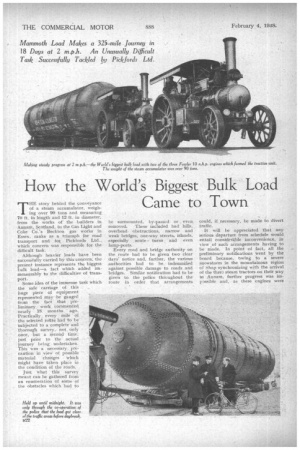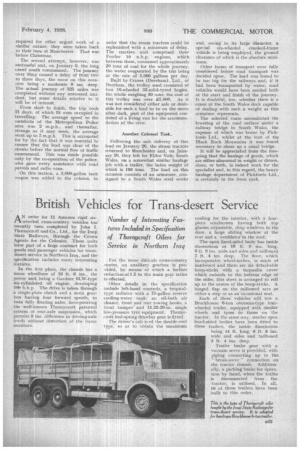How the World's Biggest Bulk Load Came to Town
Page 10

Page 11

If you've noticed an error in this article please click here to report it so we can fix it.
THE story behind the conveyance of a steam accumulator, weighing over 90 tons and measuring 70 ft. in length and 12 ft. in diameter, from the works of the builders in Annam, Scotland, to the Gas Light and Coke Co.'s Beckton gas works in Essex, ranks as a triumph for road transport and fio Pickfords Ltd., which concern was responsible for the
difficult task. .
Although heavier loads have been successfully carried by this concern; the present instance represents the biggest hulk load—a fact which added immeasurably to the difficulties of transport.
Some idea of the immense task which the safe carriage of this . huge piece of equipment represented may be gauged from the fact that pre. liminiiry work commenced nearly 18 months ago. Practically, every mile of the selected route had to be subjected to a complete and thorough survey, not Only once; but a Secondtime, just, prior to the actual journey being undertaken.
• ThiS was a necessary. pre caution in view of possible material changes Which might have taken place in the condition of the roads. Just what this survey meant can be gathered from an enumeration of some of the obstacles Which bad to be surmounted, by-passed or . even removed. These included had hills, overhead obstructions, narrow and weak bridges, one-way streets, islands, especially acute turns and even lamp-posts.
Every road and bridge authority on the route had to he. given two clear days' notice and, further, the various Authorities had to be indemnified against possible damage to roads and bridges. Similar notification had to be given to the police throughout the route in order that arrangements could, if necessary, be made to divert traffic.
It will be appreciated that any serious departure from schedule would entail considerable inconvenience, in view of such arrangements having to be Made. In point of fact, all the preliminary notifications went by the board because, bwing to a severe snowstorm in the mountainous region of Shap synchronizing with the arrival of the three steam tractors on their way to Annam, further progress was impossible and as these engines were required for other urgent work of a similar nature, they were taken back to their base at Manchester. That was before Christmas.
The second attempt, however, was successful and, on January 6, the long crawl south commenced. The journey over Shap caused a delay of from two to three days, the snow on this occasion being a moderate 9 ins. deep. The actual journey of 325 miles was completed without any untoward incident, but some details relative to it will be of interest.
From start to finish, the trip took 21 days, of which 18 were occupied in travelling. The average speed to the outskixts of the Metropolitan Police area was 2 m.p.h., and thereafter, strange as it may seem, the average went up to 8 m.p.h. This is accounted for by the fact that it was essential to ensure that the load was clear of the streets before the normal flow of traffic commenced. This was made possible only by the co-operation of the police, who gave every assistance with road patrols and radio vans.
On this section, a 3,000-gallon tank wagon was added to the column, in
order that the steam tractors could be replenished with a minimum of delay. The tractive unit comprised three Fowler 10 n.h.p. engines, which between them, consumed approximately 20 tons of coal for the whole journey, the water evaporated by the trio being at the rate of 3,000 gallons per day.
Built by Cranes (Dereham), Ltd., of Dereham, the trolley used consisted of two 16-wheeled 32-solid-tyred bogies, the whole weighing 30 tons; the cost of this trolley was over £3,000. As it was not considered either safe or desirable for such a load to be on the move after dark, part of the equipment consisted of a living van for the accommodation of the crew.
Another Colossal Task.
Following the safe delivery of this lead on January 26, the steam tractors returned to Manchester and, on January 30, they left for Ebbw Vale, South Wales, on a somewhat similar haulage job with a trailer, the laden weight of which is 103 tons. The load on this occasion consists of an armature, consigned to a •South Wales steel works and, owing to its large diameter, a
special six-wheeled , cranked-frame vehicle is being employed, the ground clearance of which is the absolute minimu um.
Other forms of transport were fully considered before road transport was decided upon. The load was found to be too big for the railways and, if it had been transported by water, road vehicles would have been needed both at the start and finish of the journey. It is doubtful, too, whether there is a crane at the South Wales dock capable of dealing with such a weight as this armature represents.
The selected route necessitated the lowering of the road surface under a railway bridge in South Wales, the expense of which was borne by Pickfords Ltd., whilst at the foot of the Black Rock Mountains it was found necessary to shore up a canal bridge.
It will be appreciated from the foregoing that the haulage of goods, which are either abnormal in weight or dimensions, or both, is indeed work for the specialist and, in this regard, the heavy haulage department of Pickfords Ltd., is certainly in the front rank.


































